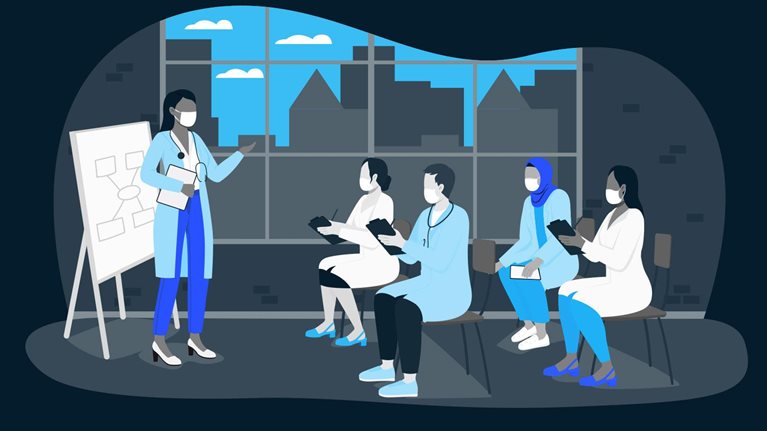The COVID-19 pandemic highlighted the importance of digitalization in supporting access to essential healthcare services in the most remote areas. With the largest disease burden globally and the most limited healthcare resources, Africa has an opportunity to use the lessons learned during the pandemic to expand its use of digital health tools (see sidebar “What we mean by ‘digital health tools’”).
Although digital health in most African regions is still in its infancy, advances in smartphone connectivity, data management policies (including to boost interoperability, privacy, and security), and data infrastructure are starting to change the ways health systems work in Africa. And rapid expansion in other areas, such as mobile financing, shows that leapfrogging is possible.
It is clear that digital health tools could play an important role in boosting health system performance in Africa, but they could also help improve efficiency. First, they could improve access to essential health services, especially for hard-to-reach populations, women, refugees, persons with disabilities, and lower-income households. In most sub-Saharan countries, more than 20 percent of the population lives more than two hours away from essential health services.1 Access is further limited by low ability to pay and relatively high cost of care. Second, improved access to patient data could help care providers make more accurate diagnoses and more effectively tailor interventions to prevent or treat disease. Digital tools could also make it easier for patients to comply with treatment plans; in 2018, a study found that only about 45 percent of clinical guidelines for many common conditions were followed in several African countries.2 Third, digital health tools could strengthen health systems’ resilience by boosting their ability to identify, respond to, and recover from health emergencies.
Finally, digital health tools could help health systems deliver care at better quality, faster, and at lower cost and thereby optimize constrained resources, including a shortage of healthcare professionals, especially in rural areas. This article focuses on measuring the impact of this fourth lever by quantifying the efficiency potential of implementing digital health tools.
We conducted an analysis to quantify the financial impact digital health tools could have in Kenya, Nigeria, and South Africa. Our findings indicate that these countries could capture efficiencies of up to 15 percent in total healthcare expenditures by 2030 (see sidebar “Methodology for calculating potential efficiency gains in 2030 total healthcare expenditures”).3 We chose these three countries for our analysis because they accounted for 85 percent of digital health start-up funding in Africa in 2021, and they have granular healthcare spending data available for analysis.
The potential efficiency gains, which could be realized without compromising quality and outcomes, vary by country. In 2030, widespread adoption could unlock $400 million to $2.5 billion in Kenya (4 to 14 percent of total projected healthcare spending), $700 million to $3.3 billion in Nigeria (4 to 10 percent of total projected healthcare spending), and $1.9 billion to $11 billion in South Africa (6 to 15 percent of total projected healthcare spending) (Exhibit 1). These gains could be reinvested in other high-priority areas to increase overall health outcomes and finance the implementation and maintenance of digital health tools. Finding efficiency gains is especially critical in budget-constrained countries, which includes most countries in Africa. Only a few African countries meet the 2001 Abuja Declaration target of allocating 15 percent of public expenditures to health.4

In this article, we outline sources of potential efficiency gains in the three countries, current opportunities to expand digital health, and actions that could accelerate and support digital health adoption.
Sources of efficiency gains
We have identified six categories of digital health tools that could create efficiencies: virtual interactions, paperless data, patient self-care, patient self-service, decision intelligence systems, and workflow automation (Exhibit 2). According to our analysis, shifting to virtual interactions and going paperless are the main drivers of potential healthcare expenditure efficiency gains in Kenya, Nigeria, and South Africa. While most care is delivered today in community and primary-care settings, these tools could be beneficial to varying degrees across care settings, from primary to tertiary care, and with increasing magnitude through 2030.
Virtual interactions
Virtual interactions account for approximately 43 percent of potential efficiency gains in Kenya (up to $1.1 billion), 35 percent in Nigeria (up to $1.2 billion), and 39 percent in South Africa (up to $4.3 billion) in 2030. These derive mainly from three types of patient-facing solutions:
Teleconsultation. Teleconsultations—remote interactions between healthcare professionals and patients, particularly for minor health issues or follow-ups—are the leading virtual-interaction tool with respect to potential efficiency gains. Additionally, patients enjoy the convenience and time savings. Broader adoption of teleconsultations could help reduce emergency admissions, improve chronic-disease management, and expand care access. Teleconsultations can also support task shifting (redistributing tasks among health workforce teams), although this was not considered in our analysis.
Remote monitoring. Remote monitoring of vital signs and symptoms could help providers more cost-effectively manage patients with one or more chronic diseases such as diabetes, congestive heart failure, and chronic obstructive pulmonary disease. Broader adoption of monitoring technologies in Africa could help reduce emergency-room care and hospital admissions, help caregivers and patients better control chronic diseases, and enable earlier interventions.
Electronic triage. Electronic triage refers to the use of AI-based online tools or phone services to determine up front whether patients need to visit an emergency room, consult with their primary-care providers (PCPs), or schedule a follow-up consultation with their caregiver. It could also help reduce nonurgent emergency-department visits, thus speeding up care for those most in need.5
Paperless data
Paperless data accounts for 30 percent of the potential efficiency gains in 2030 in Kenya (up to $700 million), 26 percent in Nigeria (up to $900 million), and 30 percent in South Africa (up to $3.3 billion). This category comprises the following solutions:
Interoperable electronic health records (EHRs). Clinicians need EHRs that comply with interoperability standards—including HL7 FHIR, a standard for the digital exchange of patient health data—to record, access, manage, and (if patient consent is granted) share patient information across care settings. Interoperable EHRs promote greater efficiency by allowing healthcare professionals to focus on high-value rather than strictly administrative tasks and reduce medical appointments for unnecessary or duplicative tests and imaging procedures. Although EHRs have been adopted as part of targeted disease programs (for example, to treat HIV and tuberculosis), they typically do not yet provide a holistic picture of patients’ medical histories for use in various care settings.
African health systems could take the opportunity to build interoperable EHR solutions more broadly across disease areas and care settings. For example, Helium Health’s core electronic-medical-records (EMR) and hospital management solution is being used by more than 7,000 medical professionals in more than 470 facilities in West Africa to treat more than 290,000 patients monthly.6 Babyl Rwanda has developed a platform that lets patients use interactive voice response over mobile phones to access a full-service digital health platform including EHRs.7
EHRs also boost the efficiency of most other digital health tools, including the following:
E-prescribing. Digital drug prescriptions can be transmitted to pharmacies in real time, reducing administrative costs and prescribing errors. When integrated with EHRs, digital prescriptions could help prevent adverse drug events by giving physicians deeper insights into potential drug interactions and a patient’s medical history.
Intrahospital staff communication. Digital platforms or software allowing electronic communication and coordination among hospital staff could be an efficient alternative to paper-based systems. This solution could increase productivity by replacing traditional, in-person multidisciplinary committee meetings and facilitating rapid doctor-to-doctor communication about patient care (leveraging a patient-centered interoperable EHR) between departments and hospitals.
AI-based virtual assistants. These tools, especially when integrated with clinical decision support systems and EHRs, could facilitate everyday work for clinicians by, for example, using AI-based voice-recognition programs to document patient notes, predicting and managing patient workflow, and helping manage charts.
Patient self-care
Patient self-care accounts for 4 percent of the potential efficiency gains in 2030 in Kenya (up to $100 million), 6 percent in Nigeria (up to $200 million), and 5 percent in South Africa (up to $500 million). It includes management applications that facilitate prescription adherence and patient education programs for chronic diseases such as mental illness, diabetes, and respiratory and cardiovascular diseases.
Adoption of self-care solutions is still low in most African countries, but the region is at a healthcare tipping point. Policies and resources today are mainly dedicated to fighting infectious diseases (primarily HIV, malaria, and tuberculosis).8 But according to the World Health Organization, noncommunicable diseases such as cancer, cardiovascular diseases, and diabetes are “increasingly becoming the main cause of mortality in sub-Saharan Africa,” where they were responsible for 37 percent of deaths in 2019, up from 24 percent in 2000.9 Disease-prevention tools, such as mobile apps, virtual coaches, and fitness trackers, could promote healthy diets and physical activity. Our analysis of self-care options also included home-based digital diagnostics such as screenings, online patient-support networks, and virtual reality to manage pain (for example, for burn victims). But according to our analysis, people in Africa tend to pursue care for curative rather than preventive measures, so these tools could have limited impact.
Patient self-service
Patient self-service accounts for 4 percent of the potential efficiency gains in 2030 in Kenya (up to $100 million), 7 percent in Nigeria (up to $200 million), and 4 percent in South Africa (up to $500 million). The key self-service technology examined in this analysis is e-booking—online portals that let patients book clinic visits, reschedule appointments, and schedule diagnostic tests. By giving patients greater control over their access to care, e-booking could reduce the costs of missed appointments and administrative costs.
Decision intelligence systems
Decision intelligence systems provide data-driven decision support for physicians and care center support staff such as nurses. They account for 9 percent of the potential efficiency gains in 2030 in Kenya (up to $200 million), 10 percent in Nigeria (up to $300 million), and 12 percent in South Africa (up to $1.3 billion). In some parts of Africa, health systems have already implemented performance dashboards that present the most crucial KPIs to help administrators and clinical leaders continually monitor care provisioning and efficiency against benchmarks in areas such as facility use, unused beds, and lengths of stay. Performance indicators are particularly helpful for identifying quality outliers, whether positive or negative, and can inform adjustments to decision making and operations in care settings—for example, to reduce variations in adherence to protocols.
This broad category also includes other digital health tools that have shown mixed results with respect to global adoption and impact. For instance, machine-learning solutions can allow payers to evaluate value-based care, identify fraud, and more. Clinical-focused systems could make differential diagnoses, interpret imaging, and make recommendations for care plans. Genomic analysis of patients could allow for better dosage determinations, thus reducing side effects and hospitalizations. And patient flow management software could better manage the transfer of patients from ward to ward to optimize length of stay and use of beds. Interventions in this category of digital health tools could be approached sequentially—for instance, starting with differential diagnosis and patient flow and advancing to genomic analysis at scale. Having the underlying capability (such as access to health data) to adopt decision intelligence systems will be fundamental to driving “leapfrog” impact from them.
Workflow automation
Workflow automation accounts for 10 percent of the potential efficiency gains in 2030 in Kenya (up to $200.0 million), 16 percent in Nigeria (up to $500.0 million), and 11 percent in South Africa (up to $1.3 billion). Workflow automation could improve the patient experience and the quality of data for clinical decision making.
Mobile connectivity via tablets, for example, could provide nurses in clinics and in remote areas with full access to patient information and enhance their ability to take care of patients through advanced communications or direct messaging with other healthcare professionals.
Health systems could unlock additional efficiency through the use of digital tools including radio-frequency identification (RFID) to track assets such as diagnostic tools, beds, and expensive drugs and to administer medications at the bedside with confirmation of all prescribed drugs. Digital tools could also support remote monitoring of vital signs for critically ill patients (a so-called electronic intensive care unit), hospital logistics with robotics performing repetitive or simple tasks, and e-referrals (referrals and discharge information forwarded to the next doctor in the patient’s journey).
Advancing the digital health landscape in Africa
Governments in Africa are increasingly setting strategies and allocating funding for digital health, shaping regulation and policies around it, and exploring opportunities to expand digital health adoption. Additionally, donors and partners are actively supporting African countries’ efforts to increase their knowledge, resources, and capabilities to sustain digital health growth. Simultaneously, enhancements in IT infrastructure and digital readiness are improving digital health affordability and adoption in the region. For example, mobile phone subscription reached 46 percent in 2021.10
As a result, Africa is currently experiencing substantial uptake in the use of digital health tools that could revolutionize service delivery. Indeed, an increasingly dynamic digital health landscape is taking shape with some start-ups and companies taking the lead in targeted regions and health categories. In the past two years, the African digital health space has seen unprecedented growth, with $123 million in investment secured by 55 start-ups in 2021 (Exhibit 3).11

Because venture capital funding started to increase significantly only in 2020 and market sizes per country are still relatively small, digital health solutions are generally still small-scale and fragmented. Most digital health companies offer stand-alone tools that address a single element of a patient journey and are not integrated with the rest of the health system. There is an opportunity to introduce more integrated digital health offerings at scale in Africa.12 Doing so would take a concerted effort by multiple stakeholders—public-health leaders, payers, providers, and start-ups—working in parallel to accomplish the following:
Establish an enabling ecosystem. As in other countries, governments could start with national digital health strategies that include measurable targets, road maps, and budgets. They could frame their existing and expanding digital ecosystem with a strong regulatory environment through data management, device regulations, and favorable reimbursement systems and could consider certification of new tools by a national agency. They could support the ecosystem with open-data standards and develop platforms and technologies that can adapt to low-resource environments—for example, slimmed-down yet still interoperable EHRs that facilitate health data exchange, e-prescriptions, and other tools. Finally, they could put in place an enabling infrastructure including, for example, nationwide coverage of mobile and internet networks, stable power supplies, and cloud-based data hosting—all supported by increased digital literacy and workforce training.
Demonstrate new or existing value. Digital health ecosystem participants could then work to identify the most pressing health system performance issues—for example, access, quality, efficiency, or resilience—and the digital tools that could improve not only efficiency but also patient access, convenience, and outcomes. They could use performance analytics to monitor progress against performance objectives and demonstrate value to citizens, clinicians, and health systems. They could codevelop user-friendly solution designs in local partnerships that involve patients and healthcare professionals and could invest in coordinated research and development of digital health tools—for example, with donor-funded initiatives or research institute projects.
Scale and sustain existing value. Social-service and public-health organizations could promote the use of certified digital health tools through campaigns or adjusted care-delivery standards. Tools that have demonstrated success in one country, particularly in low-resource environments, could then be expanded to others through partnerships with multinational organizations and intergovernmental platforms. Solution providers could also consider sustainable financing beyond donor investment—for example, with revenue-generating models, government funding, and public–private partnerships. Social-service and public-health organizations could further support the incubation of digital health solutions by setting up targeted funds and other initiatives. Finally, organizations and partners aiming to fuel innovation in Africa could create forums such as roundtables or innovation showcases to bring together stakeholders including donors, partners, innovators, companies, and clinicians.
Africa could bolster health system efficiencies through expanded use of digital health tools. For Kenya, Nigeria, and South Africa, the potential health efficiency gains could be up to 15 percent. Expanding use of virtual interactions and shifting from paper-based to interoperable digital health data exchange systems have the most promise to realize efficiency gains, although several other digital tools also show potential and warrant consideration. Countries could take action on several fronts to support the development of a digital health ecosystem and expanded use of digital health tools. This includes continuing to invest in IT infrastructure, modifying the environment, and partnering with other stakeholders to implement and scale use cases and monitor progress and performance. Increasing efficiencies is a worthy goal on its own, especially in a region with constrained resources, but reinvesting the savings could provide yet another layer of value, potentially expanding access and improving outcomes for a larger swath of the population.


